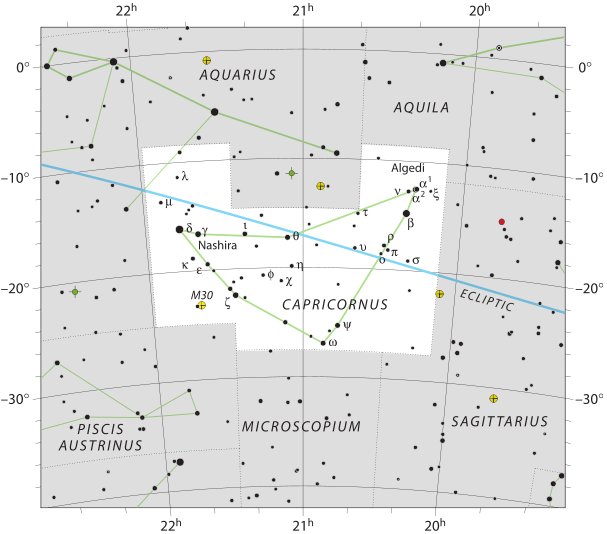In Roman times Zeus was born at Christmas Eve, when the Sun entered the house of Aegipan, the foster-brother of Zeus:
| *NOVEMBER 11 |
12 |
13 |
14 (318) |
15 |
| NOVEMBER 14 |
15 |
16 (320) |
17 |
18 (*242) |
 |
 |
 |
 |
 |
| Gb1-9 |
Gb1-10 |
Gb1-11 (240) |
Gb1-12 |
Gb1-13 |
| ε Pavonis, θ Sagittarii (302.3), γ Sagittae (302.5), μ Pavonis (302.7 |
τ Aquilae (303.8) |
20h (304.4) |
SHANG WEI (Higher Guard) = κ Cephei (305.2), θ Sagittae (305.4), TSEEN FOO (Heavenly Raft) = θ Aquilae (Ant.) (305.6), ξ Capricorni (305.8) |
TSO KE (Left Flag) = ρ Aquilae (306.3) |
| η Sagittae (304.2), δ Pavonis (304.4) |
| *January 14 |
15 |
16 |
17 |
18 (383) |
| January 17 |
18 (383) |
19 (*304) |
20 |
21 |
| °January 13 |
14 |
15 |
16 (*301) |
17 (382) |
| SOLSTICE |
'December 22 |
23 (*277) |
CHRISTMAS EVE |
25 (359) |
| "December 7 |
8 |
9 |
10 (*264) |
11 (345) |
| NAKSHATRA DATES: |
| *MAY 12 |
13 (*53) |
14 |
15 |
16 (136) |
| MAY 15 |
16 (136) |
17 |
18 |
19 |
| DRUS = χ Carinae (119.9) |
ω CANCRI (120.2) |
8h (121.7) |
ρ Puppis (122.0), HEAP OF FUEL = μ Cancri (122.1), ζ Monocerotis (122.3), ψ Cancri (122.6), REGOR = γ Velorum (122.7) |
TEGMINE = ζ Cancri (123.3) |
| χ Gemini (121.0), NAOS = ζ Puppis (121.3) |
| *July 15 |
16 |
17 (*118) |
18 |
19 (200) |
| July 18 |
19 (200) |
20 |
21 (*122) |
22 / 7 |
| °July 14 |
15 |
16 |
17 (*118) |
18 (199) |
| SOLSTICE |
'June 22 |
23 (174) |
ST JOHN'S DAY |
25 (*96) |
| "June 7 |
8 |
9 (*80) |
10 (161) |
11 |
 |
 |
 |
 |
 |
| Ga2-25 |
Ga2-26 |
Ga2-27 (57) |
Ga2-28 |
Ga2-29 |
... The tradition preserved by Hyginus in his Poetic Astronomy that the constellation Capricorn ('He-goat') was Zeus's foster-brother Aegipan, the Kid of the Goat Amalthea whose horn Zeus also placed among the stars, shows that Zeus was born at mid-winter when the Sun entered the house of Capricorn ...
... That the Sun-gods Dionysus, Apollo and Mithras were all also reputedly born at the Winter solstice is well known, and the Christian Church first fixed the Nativity feast of Jesus Christ at the same season, in the year A.D. 273. St. Chrysostom, a century later, said that the intention was that 'while the heathen were busied with their profane rites the Christians might perform their holy ones without disturbance', but justified the date as suitable for one who was 'the Sun of Righteousness' ...

Aegipan could have been born at the other side of the year, and thinking along these lines we could then count from heliacal ξ Capricorni in *NOVEMBER 14 (318) - 182 = 136 (*MAY 16).
In rongorongo times May 16 (136) was at heliacal Atlas and Alcyone (the Foundation Stone). Was Alcyone the great stone Atlas held high?

*May 16 (136) was at Gb8-26 and ºMay 16 (136) was at Gb8-27. 4 (precessional days) - 3 (missing runes) = 1 day's difference.
| *MARCH 4 |
5 (64) |
6 (*350) |
7 |
8 |
9 |
10 |
| MARCH 7 |
8 |
9 |
10 (*354) |
11 (70) |
12 (436) |
13 |
 |
 |
 |
 |
 |
 |
 |
| (229 + 229) |
Gb8-18 (230) |
Gb8-19 (460) |
Gb8-20 |
Gb8-21 |
Gb8-22 |
Gb8-23 |
| ALGENIB PERSEI = α Persei (50.0), ο Tauri (50.2), ξ Tauri (50.8)
GIENAH (γ Corvi)
|
σ Persei (51.6) |
no star listed (52) |
ψ Persei (53.1)
ACRUX (α CRUCIS)
|
δ Persei (54.7) |
Al Thurayya-27 / Krittikā-3 / Hairy Head-18 |
| TAU-ONO (Six Stones) |
Temennu-3 (Foundation Stone) |
| ATIKS = ο Persei, RANA = δ Eridani (55.1), CELAENO (16 Tauri), ELECTRA (17), TAYGETA (19), ν Persei (55.3), MAIA (20), ASTEROPE (21), MEROPE (23) (55.6) |
ALCYONE (η Tauri (56.1), PLEIONE (28 Tauri), ATLAS (27) (56.3) |
| *May 7 |
8 (*48) |
9 |
10 (130) |
11 |
12 |
13 |
| May 10 (*50) |
11 |
12 |
13 |
14 |
15 (500) |
16 (136) |
| °May 6 (*46) |
7 |
8 |
9 |
10 (130) |
11 |
12 |
| 'April 13 |
4-14 |
15 |
16 (471) |
17 (107) |
18 |
19 (*29) |
| "March 30 (454) |
31 |
"April 1 |
2 (92) |
3 |
4 (459) |
5 (*15) |
... there was no real difference between ºMarch and MAY. They represented the same month in the time-space defined from the stars and therefore the year should in principle have only 10 months. The creator of the G text has placed 2 'outside' months at the end of side b - from JANUARY 19 (384) to MARCH 21 (445) ...
*NOVEMBER 14 (318) + 120 days (= 180 - 60) = 438 = 365 + 73 (*MARCH 14, 3-14, π). This was where Gregory XIII had his ºMay 16.
|









